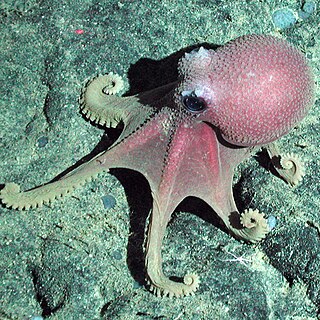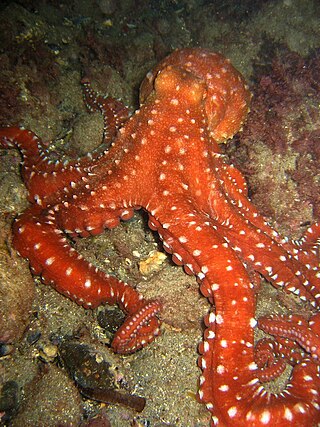
An octopus is a soft-bodied, eight-limbed mollusc of the order Octopoda. The order consists of some 300 species and is grouped within the class Cephalopoda with squids, cuttlefish, and nautiloids. Like other cephalopods, an octopus is bilaterally symmetric with two eyes and a beaked mouth at the centre point of the eight limbs. The soft body can radically alter its shape, enabling octopuses to squeeze through small gaps. They trail their eight appendages behind them as they swim. The siphon is used both for respiration and for locomotion, by expelling a jet of water. Octopuses have a complex nervous system and excellent sight, and are among the most intelligent and behaviourally diverse of all invertebrates.

A cephalopod is any member of the molluscan class Cephalopoda such as a squid, octopus, cuttlefish, or nautilus. These exclusively marine animals are characterized by bilateral body symmetry, a prominent head, and a set of arms or tentacles modified from the primitive molluscan foot. Fishers sometimes call cephalopods "inkfish", referring to their common ability to squirt ink. The study of cephalopods is a branch of malacology known as teuthology.

The splendid lanternshark is a shark of the family Etmopteridae found in the western Pacific at depths between 120 and 210 m. Through the classification of Etmopterus species into several clades based on the positioning of their bioluminescent photophores, the splendid lanternshark can be considered a member of the Etmopterus pusillus clade.

Cephalopods, which include squids and octopuses, vary enormously in size. The smallest are only about 1 centimetre (0.39 in) long and weigh less than 1 gram (0.035 oz) at maturity, while the giant squid can exceed 10 metres (33 ft) in length and the colossal squid weighs close to half a tonne (1,100 lb), making them the largest living invertebrates. Living species range in mass more than three-billion-fold, or across nine orders of magnitude, from the lightest hatchlings to the heaviest adults. Certain cephalopod species are also noted for having individual body parts of exceptional size.

Sepia latimanus, also known as the broadclub cuttlefish, is widely distributed from the Andaman Sea, east to Fiji, and south to northern Australia. It is the most common cuttlefish species on coral reefs, living at a depth of up to 30 m.

Graneledone is a genus of octopuses in the family Octopodidae. The type species is Eledone verrucosaVerrill, 1881.

Amphioctopus is a genus of octopuses comprising around 16 species.

Cephalopod ink is a dark-coloured or luminous ink released into water by most species of cephalopod, usually as an escape mechanism. All cephalopods, with the exception of the Nautilidae and the Cirrina, are able to release ink to confuse predators.

Callistoctopus macropus, also known as the Atlantic white-spotted octopus, white-spotted octopus, grass octopus or grass scuttle, is a species of octopus found in shallow areas of the Mediterranean Sea, the warmer parts of the eastern and western Atlantic Ocean, the Caribbean Sea, and the Indo-Pacific region. This octopus feeds on small organisms which lurk among the branches of corals.

Macroctopus maorum is known more commonly as the Maori octopus or the New Zealand octopus. It is found in the waters around New Zealand and southern Australia. M. maorum is one of the largest and most aggressive octopus species living in the New Zealand and Australian waters. They feed mainly on crustaceans and fish. Although they have a short life span, the females lay thousands of eggs and are very protective of them.

Octopus aquaculture describes the captive-raising of octopuses and commercial sale of their meat. A complex and labor-intensive form of farming, octopus aquaculture is being driven by strong market demand in the Mediterranean and in South American and Asian countries. Annual global demand for octopus more than doubled from 1980 to 2019, from roughly 180,000 to about 370,000 tons. The supply of octopus has been constrained by overfishing in many key fisheries and proponents of farming suggest human-induced culturing could help restock natural populations. Opponents of the nascent industry argue that cephalopod intelligence and emotional capacity, as well as the solitary and carnivorous character of octopuses, make them particularly ill-suited to intensive, captive breeding. Commercial sale may stimulate market demand, hastening rather than offsetting the decline in wild stocks. An announcement that a Spanish firm would begin octopus aquaculture as early as 2022 prompted ethical and scientific controversy.
Aggregata is a genus of parasitic alveolates belonging to the phylum Apicomplexa.

Louise Allcock is a British researcher, best known for her work on ecology and evolution of the cephalopods of the Southern Ocean and deep sea. She is the editor of the Zoological Journal of the Linnean Society.

Wunderpus photogenicus, the wunderpus octopus, is a small-bodied species of octopus with distinct white and rusty brown coloration. 'Wunderpus' from German “wunder” meaning ‘marvel or wonder’.

Octopus bimaculatus, commonly referred to as Verrill's two-spot octopus, is a similar species to the Octopus bimaculoides, a species it is often mistaken for. The two can be distinguished by the difference in the blue and black chain-like pattern of the ocelli. O. bimaculatus hunt and feed on a diverse number of benthic organisms that also reside off the coast of Southern California. Once the octopus reaches sexual maturity, it shortly dies after mating, which is approximately 12–18 months after hatching. Embryonic development tends to be rapid due to this short lifespan of these organisms.

Gretta T. Pecl is an Australian marine ecologist, Australian Research Council Future Fellow, and the Director of the Centre for Marine Socioecology (CMS) at the University of Tasmania. Her work focuses on species and ecosystem responses to climate change, as well as using socioecological approaches to adapt natural resource management for climate change. She is on the editorial board of Springer Nature's Reviews in Fish Biology and Fisheries, and is a Subject Editor for Ecography.
Octopus oliveri, is a species of octopus found in the western Pacific Ocean off the coast of Japan, Hawaii, and Kermadec Island, in reefs and boulder coasts.

Octopus insularis is a species of octopus described in 2008 from individuals found off the coast of Brazil, with a potentially much larger range.

Octopus sinensis is a mollusk belonging to the class Cephalopoda. Octopus sinensis is a well-known shallow-water benthic octopus species found in the coastal, temperature waters of South Korea, China, and Japan, with the species name, sinensis being Latin for Chinese. Octopus sinensis is closely related to the Atlantic and Mediterranean common octopus, Octopus vulgaris. Because of the morphological similarities, O. sinensis was considered synonymous with Octopus vulgaris until 2017. Octopus sinensis are carnivores that prey upon on many shallow-water animals such as crustaceans and mollusks.

Abdopus abaculus, or the mosaic octopus, is a species of pygmy octopus. It was first described as Octopus abaculus by M. D. Norman and M. J. Sweeney in 1997 based on specimens caught in Zamboanga del Norte, Philippines.



















